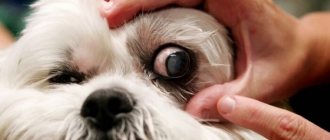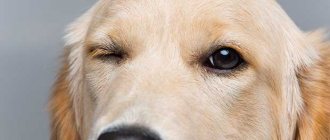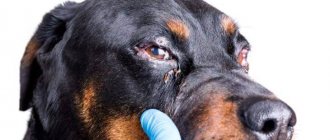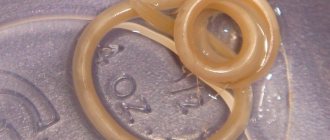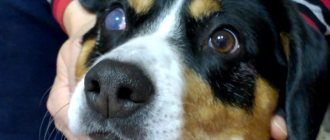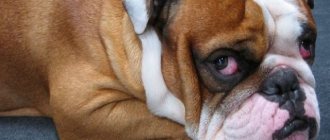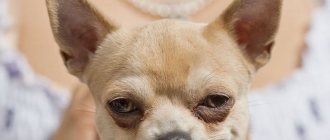Why do they fall out?
The main reason is the structure of the skull, but there are also a number of associated factors. Dogs with skulls like the pug's are called brachycephalic.
The eyeball may fall out due to a head blow or a fight with another dog. Sometimes the cause may be careless lifting of the animal by the skin on the shoulder blades. Other causes include the following conditions:
- severe stress;
- chronic constipation;
- flick;
- improper eye care;
- weakened immune system;
- hematoma after injury in the temporal region;
- increased intracranial pressure;
- neoplasm.
Due to the mechanical impact, the eyeball shifts and then completely extends beyond the eyelid. The loss can be either partial or complete.
In some cases, chronic hydrocephalus occurs. It is impossible to completely cure such a pathology. The only thing the owner can do is provide supportive therapy aimed at improving the pet’s quality of life.
It is important to establish the cause of this phenomenon in order to exclude the possibility of developing a serious disease.
First aid
When detached from the fundus, the eye becomes very red and bulges. During this action, the pug does not feel any discomfort; the deformed organ does not interfere.
icon-bell
The eyes are the weak point of any purebred dog. It is poorly protected and very vulnerable.
Therefore, it is important to regularly clean and apply eye drops to your Pug.
For this you will need a medical physical therapist. solution: apply a few drops to a dry cotton pad and wipe around the eye area in the evenings.
We recommend purchasing drops for redness and inflammation of the eyes at a pet pharmacy and using them according to the instructions. Take your animal to the veterinarian at least once every six months, because prevention is always better than cure.icon-bell
If you have an unexpected situation and one or both of your dog's eyes fall out, remain calm. Judiciously and promptly take your pug to the veterinarian, where the doctor will replace the deformed organ in place.icon-bell
After applying first aid, apply gauze pads to your pet's eyes and secure them. Try to let the pug lie quietly or sit without sudden movements.
On the way to the hospital, do not allow your dog to touch the injured part of the body with its paws or move actively - this can cause complications.
If you have experience with eye loss in a pug breed, you can help him yourself. Wash your hands with soap and use a thin piece of gauze to lightly press the pupil in the desired direction. The organ should return to its original position.
If a pug's eyes fall out, remember that help must be timely, otherwise the animal's organ may atrophy, significantly worsening the quality of life. Even a delay of half an hour can cost your pet his sight.
Regular eye care is the main preventative measure to prevent eye loss. Several times a year it is necessary to visit a veterinary clinic for an examination, which includes diagnostics of the organ of vision.
Prevention also includes compliance with the following rules:
- The pet’s place in the house must be clean; regular dry and wet cleaning is required;
- ensuring safety: do not let the pug jump from a height, prevent contact with sharp objects, avoid potentially dangerous places;
- preventing fights with other dogs on walks;
- preventing close contact with dogs and other animals infected with various diseases;
- trimming nails regularly to prevent your pet from injuring itself;
- bathing carefully so that the shampoo does not get into your eyes.
Veterinarians advise all pug owners to have several eye ointments with disinfectant and anti-inflammatory effects at home. It is also important to monitor their expiration date; if the drug is old, replace it with a new one.
If your pug's eyes fall out, this could be a sign of either eye or head injury, or a symptom of a serious illness. It is important to detect the phenomenon in time; this requires regular examination of the pet. Taking preventive measures will help prevent hair loss.
All dog eye diseases can be divided into three types:
- infectious - inflammation that occurs against the background of a general infection with a virus or infection in the visual organ;
- non-infectious (mechanical) – diseases due to eye injury;
- congenital (genetic) occur due to abnormal intrauterine development or against the background of hereditary pathology.
We suggest you read: The cat often sneezes, reasons and what to do
Pekingese have large round eyes.
Such a beautiful unusual shape, unfortunately, becomes the cause of the frequent development of diseases of the organ of vision.
Conjunctivitis
Conjunctivitis is an inflammation of the conjunctiva caused by the entry of an irritant or pathogen from the air onto the mucous membrane. The disease rarely manifests itself as an independent process; more often it is a symptom of an infectious infection of the body.
Causes of conjunctivitis:
- mechanical (injuries, bruises, burns, frostbite);
- allergic (irritation with allergen);
- fungal and viral infections;
- dermatitis;
- metabolic disease;
- ingrown eyelashes;
- micronutrient deficiency.
There are follicular conjunctivitis (inflammation of the third eyelid with the formation of follicles), catarrhal (mechanical), purulent (due to a viral disease) and allergic.
Each type has different symptoms. General characteristics of conjunctivitis: redness of one or both eyes, mucous yellow or transparent discharge in the corners, increased lacrimation, itching, pain, swelling of the eyelids.
Cataract
The second name of the disease is gray star. It is a complete or partial darkening or clouding of the lens capsule. There are primary and secondary forms of cataracts.
Pekingese and related Asian breeds are characterized by a primary type - hereditary. The disease appears for no apparent reason at 6–7 years of age. It is impossible to prevent the development of the problem, but it is possible to diagnose it in the early stages and stop the process.
The secondary type appears due to abnormal deformations of the eyeball after serious injury, untreated infectious diseases, and diabetes mellitus.
Corneal erosion
Corneal erosion is another name for “superficial keratitis.” Characterized by damage to the epithelium and inflammation of the cornea. Looks like a green or bluish spot on the cornea. The root cause of the pathology is an untreated inflammatory process in the visual organ (infectious conjunctivitis, for example).
The disease develops gradually: first, swelling appears, blood vessels become noticeable, and the cornea becomes cloudy. With prolonged absence of treatment, peptic ulcer disease and pigmentary keratitis develop.
First, the cause that caused the erosion is treated. Recovery is carried out using antibacterial drops. Less commonly, surgical intervention is required - closing the affected area with the third eyelid.
Other diseases
The dog may also suffer from pathological changes in the upper and lower eyelids:
- blepharitis (unilateral or bilateral inflammation);
- entropion of the eyelid;
- eversion of the century.
Uveitis is often found in pugs, Pekingese and similar breeds - inflammation of the mucous membrane and iris; Ulcerative keratitis is a severe inflammation of the cornea. Glaucoma occurs - a green star associated with increased pressure inside the eye.
Atrophy is an incurable hereditary disease, which, unlike detachment, proceeds slowly. The animal becomes blind with age and the pupil becomes cloudy.
Eye loss is a hereditary disease in miniature dogs associated with the special shape of the eye socket. The eyes of the pug, spitz, shih tzu, japanese chin and tibetan spaniel are prone to pathology. But if a Pekingese's eyes fall out, most often to the full size of an apple, then the eye loss of a pug may be unnoticeable.
Protruding eyes look different. If the eyeball has fallen out, it does not always completely extend beyond the orbit; it can only protrude slightly beyond the orbit. Sometimes a missing eye looks like it has been crushed. The most difficult and terrible position of a dislocated apple is hanging on the eye muscle.
Causes of loss
Typically, those dogs whose eyeballs are “protruding” are prone to eye loss. Although the breed standards, in particular for the Pekingese, do not allow this form. The correct apples should match the shape and size of the eye socket.
However, the anatomical shape of the palpebral fissure makes Pekingese, Pugs, Japanese Chins and Shih Tzus susceptible to eye loss. This can happen when jumping from a high object or under severe stress. Often the cause is eye injury.
Chihuahuas' eyes most often fall out due to the fact that their owners handle them carelessly: they drop them, they allow them to go down steep stairs on their own.
First aid
The main thing is not to panic. The more time passes from the moment the eyeball falls out until assistance is provided, the more difficult the procedure and subsequent recovery will be. If no more than 15 minutes have passed, and the prolapse is insignificant, then you can perform the reduction yourself.
- Disinfection of hands and surfaces on which the “operation” will be performed. It is better to choose a non-slip surface.
- Fixing the dog in a comfortable position. It's a good idea to use a helper. You need to hold the Pekingese with its muzzle up. To prevent the pet from moving, take it by the lower jaw, and with the other hand, spread the upper and lower eyelids of the affected eye.
- Using a napkin soaked in saline solution or warm boiled water, gently press on the fallen apple. The hand will feel how the eye has moved into place.
- The napkin is left on the eye, and the Pekingese is taken to the veterinarian for an examination.
Treatment
The stitches placed on the missing eye are not removed for a month. To prevent the development of keratitis or conjunctivitis, Pekingese are given eye drops of antibacterial solutions (Tsiprovet, Dekta, Trixie). If the pet tries to tear off the stitches, an Elizabethan collar is put on it.
If the eye cannot be saved - atrophic processes have begun, it is removed. This will not prevent the animal from enjoying life, but it will change its appearance. Pekingese with eye injuries do not participate in exhibitions and show programs.
If assistance is not provided in a timely manner after a loss, and the lack of proper treatment and restorative care, serious complications arise that can harm the health of the Pekingese as a whole:
- corneal ulcer;
- strabismus;
- sudden deterioration of vision;
- blindness;
- disruption of the optic nerve.
What to do?
If a dog's eye falls out, you need to give it first aid. It is important that the animal is in a calm state. If there is a dog collar, it is better to wear it. This is necessary so that the pug cannot reach the injured area with its paw.
The picture of a prolapse in itself is quite frightening, so the owner must remain calm in order to help the dog as quickly as possible.
The damaged eye is cleaned of dust and dirt. You can use saline solution to moisten the cornea. The injured area is coated with a special ointment, and then ice is applied to it. It is held for 10-15 minutes. Cold helps relieve swelling and reduce bleeding.
The damaged eye is covered with a damp cloth. Only after providing such first aid can you take the dog to the doctor.
It is not recommended to feed the animal before visiting the doctor, as it may require anesthesia.
Do not use alcohol or other antiseptics for cleaning. These aggressive substances can damage the cornea, as a result the animal will lose its vision. You should not use cotton wool, as its particles may remain in the eye. Instead, sterile swabs can be used, one for each eye.
Only a specialist can assess the degree of eye injury and provide full assistance. It is strictly forbidden to insert it yourself, as you can get an infection that will provoke an inflammatory process and a number of associated complications.
If the eye falls out completely, it can no longer be inserted back. There is a myth that the eyeball can fall out on the floor, but this cannot happen.
After the doctor puts the eyeball in place, you need to ensure complete rest. The head is wrapped in gauze, and the pug must remain motionless for several hours. If you follow all the doctor’s recommendations, the animal will recover fairly quickly.
Hair loss cannot be treated therapeutically. In this case, surgical intervention is required. The operation is carried out in several stages:
- Cleansing with dioxidine 1% and novocaine.
- Injecting a hydrocortisone solution directly into the eye.
- Dissection of adhesions on the eyelid.
- Reinstalling the eyeball.
- Applying an antibacterial agent and fixing the bandage.
To prevent possible complications after surgery, the dog must be given antibiotics. The optimal duration of taking such drugs is 7 days.
After completing the preventive course, the eye is re-treated. For this purpose, antimicrobial and painkillers are used. The exact time when the bandage can be completely removed depends on the characteristics of the dog and the extent of the damage.
With a successful outcome, the eye muscles recover in 1-2 months. If you do not follow the veterinarian’s recommendations or remove the stitches too early, a number of complications may arise:
- complete loss of vision;
- atrophy of the eyeball;
- cataract;
- increased intraocular pressure;
- strabismus.
To avoid such negative manifestations, it is necessary to ensure complete rest, a balanced diet and compliance with all the doctor’s requirements. During the rehabilitation period, it is necessary to especially carefully monitor the dog’s condition and, if necessary, immediately contact a specialist.
Do pugs' eyes fall out - reasons
Eye loss is not an independent disease, but only a symptom of one of the possible ones. To find out why this happened, you need to conduct an examination. Only an experienced veterinarian can make a diagnosis. The main reasons for loss are:
- increased intracranial pressure;
- hydrocephalus of the brain;
- hematomas after head injury;
- tumors, other neoplasms (of different nature).
There are often cases when the cause of deformation of the eyeball is a head injury. Considering the small size of the breed, you can be sure that it doesn’t take much force to hit them. Sometimes it’s enough just to jump off the sofa unsuccessfully and hit the corner of the door. Such household injuries are absolutely safe for larger animals, but for miniature pugs they do not go unnoticed.
Sometimes it happens that a dog is injured by a person. This often happens when a pet grows up in a family with small children who are not averse to frolicking with it. A child can easily accidentally push or hit a pet, which will cause serious head damage. Owners are also prohibited from using force when raising pugs.
In the case of hydrocephalus, the appearance of neoplasms, and other diseases for which treatment is impossible, maintenance therapy is prescribed to prevent symptoms of the disease such as eye loss. If there is a chance to recover from the provoking illness, for example, if it is pressure surges, after recovery the risk of recurrent problems with the organ of vision goes away.
Eye loss in a pug is difficult to confuse with any other disorder. The owner will notice this by only briefly glancing at his pet. No, they do not fall to the floor and do not hang on vessels. The eyeball only bulges, protrudes beyond the boundaries of the orbit and stands out strongly against the background of the muzzle, which is especially noticeable during its movements. This is accompanied by:
- rupture of blood vessels, which leads to redness of the protein;
- sometimes the appearance of bloody discharge;
- swelling of the conjunctiva;
- increased lacrimation;
- frequent blinking;
- increased sensitivity to light;
- painful sensations.
In fact, this problem occurs quite often and not only in pugs. A special structure of the skull is observed in Pekingese, Japanese Chins, and Shih Tzu. All these breeds, and especially pugs, also have problems with the respiratory system. Every owner of these dogs knows that they snore and grunt very often.
As for the eyes, by and large they are protected only by the eyelids; the skull practically does not support them. Therefore, even a slight blow to the head can cause a pug’s eye to fall out. This problem can also be caused by the owners themselves when they carelessly grab the dog by the skin on the shoulder blades. Moreover, such pets should generally be treated very carefully, otherwise the eye problem may become a regular occurrence, which has an extremely bad effect on the overall health of the animal.
Note! The older the pug, the greater the chance of eye loss, and it is not uncommon for two eyeballs to fall out at once. This is all due to the fact that over time the elasticity of tissues decreases significantly.
Every owner of this breed of dog should acquire the most common saline solution: over time it will definitely come in handy. It is also recommended to have gauze at home. It must be folded several times and thoroughly soaked in saline solution, then applied to the eye. Carefully bandage it and immediately go to the veterinarian; the sooner you do this, the fewer consequences there will be for your pet.
Of course, the necessary funds are not always available at home. In this case, it is recommended to take some clean water and lightly salt it. Then you will need a clean scarf that needs to be soaked in this water. And then carry out the same procedure as in the case described above. And yet, if a pug’s eye falls out (in the photo you can see how the dog will feel after a successful procedure to return the eyeball to its place), it is better to immediately take him to the veterinarian.
The specialist will put the eye back in place, bandage it, and the dog should walk until it is completely restored. It should take 3-7 days in total. If this happens to the animal regularly, then a decision may be made to sew up the eyelid, then again you will have to return to the veterinarian to have the stitches removed.
For a speedy recovery, your pet should treat its eyes once a day with saline solution or hydrocortisone ointment, which can be purchased at any pharmacy. With this type of care, the pug’s recovery process will go much faster.
Dogs of this breed, such as pugs, were bred in China.
The height of these friendly four-legged friends is 30-36 cm if we are talking about a male, and 25-30 cm when we are talking about a female. As you can see, these are quite miniature animals.
Pugs live from 12 to 15 years. This breed of dog is perfect for keeping in urban environments.
And even those dog lovers who do not have extensive experience in caring for animals will be able to cope well with caring for pugs and become excellent pet owners.
However, in some cases, these kind and friendly creatures begin to lose their eyes.
Within the framework of today's topic, we will talk about why the eyes of this breed of dog can fall out, how to detect this phenomenon at the initial stage and provide first aid to your pet in such a situation.
Experts cite the structural features of the skull in these animals as the first reason for such an unpleasant and very serious disease.
It is worth noting that pugs, along with some other dog breeds, belong to the category of four-legged animals that are scientifically called brachycephalic. By the way, such dogs need a special muzzle.
Such animals are distinguished by characteristic anatomical features. This may include the presence of some problems with the respiratory system, increased salivation, as well as poor protection of the eyeballs.
If you look at a pug from the outside, you can say that in fact the eyes of this pet are protected exclusively by eyelids.
At the same time, in practice it is possible to observe both the loss of one of the eyes and both at the same time.
Diagnostic methods
It is hardly possible to confuse such a state with something else.
If something like this happens to a pet, you can first understand it by its unaesthetic appearance.
In the process of moving attention between objects or people, the animal’s eyes will clearly stand out against the background of the muzzle.
In addition, it will be possible to observe the inflammatory process, redness of the eyes, as well as burst blood vessels. Against the backdrop of all the processes taking place, the appearance of the animal will be distinguished by soreness.
First aid
It is quite natural that if such a situation happens for the first time, the animal’s owners may be confused, not knowing what to do in the current circumstances.
In such a case, there is no need to panic.
Pug owners should always ensure that the simplest saline solution is always present in their home medicine cabinet.
It is unlikely that you will be able to do without this remedy if, for example, a speck gets into your pet’s eye.
Fixing the eyeball in the correct position will not be difficult.
To do this, you will need clean gauze, which should be folded several times and thoroughly wetted with the solution. Afterwards, the moistened gauze cloth should be applied to the missing eye and securely secured with a bandage.
If it happens that there is no gauze or solution available, then you can use a clean handkerchief.
Sometimes the veterinarian is forced to stitch the dog's eyelid shut. After an appropriate period of time, the applied sutures are removed.
In order to speed up the healing process, experts recommend treating the pug's eyes with saline solution, and also using hydrocortisone ointment for this.
We suggest you read: The cat spits up after eating, reasons for what to do
It is quite possible to put the eye back in place without the help of a doctor. To do this, you should first wash your hands with soap, then gently press your finger on the apple of your eye, which will allow you to return it to its place.
Then you need to moisten the animal’s eyelids and apply a sterile bandage.
If first aid is provided incorrectly or is absent, the dog’s visual organ may atrophy.
As for veterinarians, they recommend not postponing your pet’s visit to a specialist if such a problem arises.
“Depending on existing opportunities, you should not put off a visit to the veterinarian for a long time.
All this is fraught with drying out of the eye and the development of an inflammatory process, which may require longer and deeper treatment.”
It should be noted that there are no specific therapeutic treatments for eye loss in pugs.
In such a situation, the dog will undergo surgery, during which the missing eye will be returned to its place.
This type of surgery is performed under general anesthesia and consists of the following steps:
- removing contaminants by washing the eyes;
- injection of a hydrocortisone solution and dissection of the resulting adhesions of the eyelid;
- returning the missing eye to its place;
- application of antibacterial ointment and fixing bandage.
After surgery, the animal must be given antibiotics. After a week, the visual organ is re-treated.
Only the veterinarian will determine the final time for removing the fixing bandage.
The eye muscles recover completely within a few months (shown in the photo). Sometimes what happens is that the dog's optic nerve is completely severed. In this situation, the animal's eyeball is completely removed.
In certain cases, when the integrity of the internal eye muscle is compromised, the dog may develop strabismus or neuritis.
Photo
In the photo below you can see what prolapse looks like in pugs and other dog breeds.
Prevention
It is necessary to properly care for your pug's eyes, as well as systematically undergo a preventive examination by a doctor. It is important to ensure that the dog does not hit its head anywhere during walks. Other preventive measures include:
- timely trimming of claws;
- walking only on low-mown grass;
- clearing mucus.
Veterinarians advise having anti-inflammatory and disinfectant ointment at home. They are needed to provide first aid. It is also important to monitor the expiration date of the drugs, as they may be ineffective.
